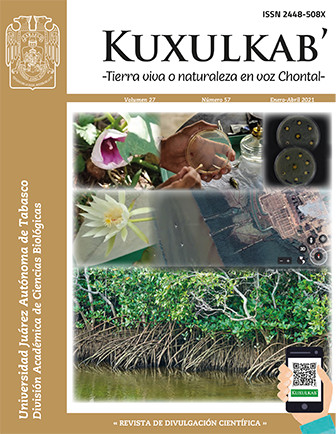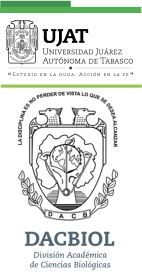EVALUACIÓN in vitro DE EXTRACTOS DE PLANTAS MEDICINALES COMO POSIBLES AGENTES ANTIMICROBIANOS PARA BACTERIAS PATÓGENAS EN TILAPIA
DOI:
https://doi.org/10.19136/kuxulkab.a27n57.3702Palabras clave:
Fitoterapia, Acuicultura, Microbiología, GuatemalaResumen
A nivel mundial, la acuicultura ha crecido dramáticamente en los últimos 50 años, causando impactos negativos en la salud de los peces debido al incremento de enfermedades bacterianas. Los productores de tilapia usualmente tratan las enfermedades con una variedad de antibióticos, promoviendo la resistencia bacteriana. El objetivo de este estudio fue determinar el efecto antimicrobiano de cinco extractos de plantas medicinales frente a ocho bacterias patógenas aisladas de cultivos de tilapia en Guatemala. De los extractos evaluados, 'Syzygium aromaticum', 'Pimienta dioica' y 'Rosmarinus officinalis' inhibieron el crecimiento de seis, cinco y tres bacterias, respectivamente. Los extractos presentaron características antimicrobianas de amplio espectro, tanto para bacterias Gram negativas y positivas. Los extractos con mayor actividad antimicrobiana fueron 'S. aromaticum' y 'R. officinalis' con concentraciones mínimas inhibitorias y bactericidas entre 300 ppm a 1,563 ppm. Los extractos de 'Cinnamomum verum' y 'Lippia graveolens' no inhibieron las bacterias patógenas aisladas.
Descargas
Referencias
Abdul Razak, R.; Shariff, M.; Yusoff, F.M. & Safinar Ismail, I. (2019). Bactericidal efficacy of selected medicinal plant crude extracts and their fractions against common fish pathogens. Sains Malaysiana, 48(8): 1601-1608. DOI «http://dx.doi.org/10.17576/jsm-2019-4808-05»
Abutbul, S.; Golan-Goldhrish, A.; Barazani, O. & Zilberg, D. (2004). Use of 'Rosmarinus officinalis' as a treatment against 'Streptococcus iniae' in tilapia ('Oreochromis sp.'). Aquaculture, 238(1-4): 97-105. DOI «https://doi.org/10.1016/j.aquaculture.2004.05.016»
Alagawany, M.; Farag, M.R.; Salah, A.S. & Mahmoud, M.A. (2020). The role of oregano herb and its derivatives as immunomodulators in fish. Reviews in Aquaculture, 12(4): 2481-2492. DOI «https://doi:10.1111/raq.12453»
Alderman, D.J. & Smith, P. (2001). Development of draft protocols of standard reference methods for antimicrobial agent susceptibility testing of bacteria associated with fish diseases. Aquaculture, 196(3-4): 211-243. DOI «https://doi.org/10.1016/S0044-8486(01)00535-X»
Bulfon, C.; Volpatti, D. & Galeotti, V. (2015). Current research on the use of plant-derived products in farmer fish. Aquaculture Research, 46(3): 513-551. DOI «https://doi.org/10.1111/are.12238»
Buller, N.B. (2004). Bacteria from fish and other aquatic animals: a practical identification manual. United Kingdom: CABI, Publishing.
Citarasu, T. (2010). Herbal biomedicines: a new opportunity for aquaculture industry. Aquaculture International, 18: 403-414. DOI «https://link.springer.com/article/10.1007/s10499-009-9253-7»
Das, R.; Raman, R.P.; Saha, H. & Singh, R. (2015). Effect of 'Ocimum sanctum' Linn. (Tulsi) extract on the immunity and survival of 'Labeo rohita' (Hamilton) infected with 'Aeromonas hydrophila'. Aquaculture Research, 46(5): 1111-1121. DOI «https://doi.org/10.1111/are.12264»
Dorman, H.J.D. & Deans, S.G. (2000). Antimicrobial agents from plants: antibacterial activity of plant volatile oils. Journal of Applied Microbiology, 88(2): 308-316. DOI «https://doi.org/10.1046/j.1365-2672.2000.00969.x»
Dube, K. & Chanu, T.I. (2012). Organic aquaculture: way to sustainable production. In: Goswami, U.C. (Ed.); Advances in Fish Research, (pp. 219-229). Recovered from «https://www.researchgate.net/publication/262903857»
FAO (Food and Agriculture Organization). (2020a). El estado mundial de la pesca y la acuicultura 2020: la sostenibilidad en acción, (Serial title: "The State of World Fisheries and Aquaculture (SOFIA)"; p. 243). Roma. DOI «https://doi.org/10.4060/ca9229es»
FAO (Food and Agriculture Organization). (2020b). Global Aquaculture Production 1950-2018. Fishery Statistical Collections (FIGIS): global aquaculture production (2018) [Web]. Consulted in «http://www.fao.org/fishery/statistics/global-aquaculture-production/query/en»
García Pérez, J. (2013). Analysis of competitiveness of tilapia industry: case Guatemala vs. Honduras, (Master's Thesis in Aquaculture). Taiwan: National Taiwan Ocean University.
Harikrishnan, R.; Balasundaram, C. & Heo M.S. (2011b). Impact of plant products on innate and adaptive immune system of cultured finfish and shellfish. Aquaculture, 317(1-4): 1-15. DOI «https://doi.org/10.1016/j.aquaculture.2011.03.039»
Harikrishnan, R.; Kim, J.S.; Kim, M.C.; Balasundaram, C. & Heo, M.S. (2011a). 'Lactuca indica' extract as feed additive enhances immunological parameters and disease resistance in 'Epinephelus bruneus' to 'Streptococcus iniae'. Aquaculture, 318(1-2): 43-47. DOI «https://doi.org/10.1016/j.aquaculture.2011.04.049»
Lee, S.; Najiah, M.; Wendy, W. & Nadirah, M. (2009). Chemical composition and antimicrobial activity of the essential oil of 'Syzygium aromaticum' flower bud (Clove) against fish systemic bacteria isolated from aquaculture sites. Frontiers of Agriculture in China, 3: 332-336. DOI «https://doi.org/10.1007/s11703-009-0052-8»
Livermore, D.M. (2002). Multiple mechanisms of antimicrobial resistance in 'Pseudomonas aeruginosa': our worst nightmare?. Clinical Infectious Diseases, 34(5): 634-640. DOI «https://doi.org/10.1086/338782»
Lødemel, J.B.; Mayhew, T.M.; Myklebust R.; Olsen, R.E.; Espelid, S. & Ringø, E. (2001) Effect of three dietary oils on disease susceptibility in Arctic charr ('Salvelinus alpinus' L.) during cohabitant challenge with 'Aeromonas salmonicida ssp. salmonicida'. Aquaculture Research, 32(12): 935-945. DOI «https://doi.org/10.1046/j.1365-2109.2001.00621.x»
Lovkova, M.Y.; Buzuk, G.N.; Sokolova, S.M. & Kliment’eva N.I. (2001) Chemical features of medicinal plants (Review). Applied Biochemistry and Microbiology, 37: 229-237. DOI «https://doi.org/10.1023/A:1010254131166»
Majolo, C.; da Rocha, S.I.B.; Chagas, E.C.; Chaves, F.C.M. & Bizzo, H.R. (2017). Chemical composition of 'Lippia spp.' essential oil and antimicrobial activity against 'Aeromonas hydrophila'. Aquaculture Research, 48(5): 2380-2387. DOI «https://doi.org/10.1111/are.13073»
Marroquín Mora, D.C. & García-Pérez, J.R. (2015). Evaluación 'in vitro' de extractos de plantas medicinales y probióticos como posibles agentes antimicrobianos para el control de las infecciones bacterianas más comunes en tilapia 'Oreochromis spp.', (Informe final 2015- 4.8.26.7.27). Centro de Estudios del Mar y Acuicultura (CEMA), Instituto de Investigaciones Hidrobiológicas (IIH); Universidad de San Carlos de Guatemala. DOI «http://doi.org/10.13140/RG.2.2.15760.76806»
Ostrand, S.L.; Glenn, R.A.; Gannam, A.L. & Hanson, K.C. (2012). Inhibitory effects of Rosemary Oil on the in vitro growth of six common finfish pathogens. North American Journal of Aquaculture, 74(2): 230-234. DOI «https://doi.org/10.1080/15222055.2012.675995»
Pascual, M.E.; Slowing K.; Carretero E.; Sánchez Mata D. & Villar, A. (2001). Lippia: traditional uses, chemistry and pharmacology: a review. Journal of Ethnopharmacology, 76(3): 201-214. DOI «https://doi.org/10.1016/S0378-8741(01)00234-3»
Rattanachaikunsopon, P. & Phumkhachorn, P. (2009). Prophylactic effect of 'Andrographis paniculata' extracts against 'Streptococcus agalactiae' infecting Nile tilapia ('Oreochromis niloticus'). Journal of Bioscience and Bioengineering, 107(5): 579-582. DOI «https://doi.org/10.1016/j.jbiosc.2009.01.024»
Rattanachaikunsopon, P. & Phumkhachorn, P. (2010). Potential of cinnamon ('Cinnamomum verum') oil to control 'Streptococcus iniae' infection in tilapia ('Oreochromis niloticus'). Fisheries Science, 76: 287-293. DOI «https://doi.org/10.1007/s12562-010-0218-6»
Reverter, M.; Bontemps, N.; Lecchini, D.; Banaigs, B. & Sasal, P. (2014). Use of plant extracts in fish aquaculture as an alternative to chemotherapy: current status and future perspectives. Aquaculture, 433: 50-61. DOI «https://doi.org/10.1016/j.aquaculture.2014.05.048»
Roomiani, L.; Soltani, M.; Akhondzadeh-Basti, A.; Mahmoodi, AT.; Mirghaed, A. & Yadollahi, F. (2013). Evaluation of the chemical composition and in vitro antimicrobial activity of 'Rosmarinus officinalis', 'Zataria multiflora', 'Anethum graveolens' and 'Eucalyptus globulus' against 'Streptococcus iniae' the cause of zoonotic disease in farmed fish. Iranian Journal of Fisheries Sciences, 12(3): 702-716. Recovered from «http://jifro.ir/article-1-1104-en.pdf»
Silveira-Coffigny, R. (2006). Los productos fito-farmacéuticos en la acuicultura. Revista Electrónica de Veterinaria REDVET, 7(8): 1-10. Recuperado de «https://www.redalyc.org/pdf/636/63612750012.pdf»
Sivaram, V.; Babu, M.M.; Immanuel, G.; Murugadass, S.; Citarasu, T. & Marian, M.P. (2004). Growth and immune response of juvenile greasy groupers ('Epinephelus tauvina') fed with herbal antibacterial active principle supplemented diets against 'Vibrio harveyi' infections. Aquaculture, 237(1-4): 9-20. DOI «https://doi.org/10.1016/j.aquaculture.2004.03.014»
Stratev, D.; Zhelyazkov, G.; Noudou, X.S. & Krause, R.W.M. (2018). Beneficial effects of medicinal plants in fish diseases. Aquaculture International, 26: 289-308. DOI «https://doi.org/10.1007/s10499-017-0219-x»
Talpur, A.D.; Ikhwanuddin, M. & Bolong, A.M.A. (2013) Nutritional effects of ginger ('Zingiber officinale' Roscoe) on immune response of Asian sea bass, 'Lates calcarifer' (Bloch) and disease resistance against 'Vibrio harveyi'. Aquaculture, 400: 46-52. DOI «https://doi.org/10.1016/j.aquaculture.2013.02.043»
Van Hai, N. (2015). The use of medicinal plants as immunostimulants in aquaculture: a review. Aquaculture, 446: 88-96. DOI «https://doi.org/10.1016/j.aquaculture.2015.03.014»
Watanabe, W. O.; Losordo, T. M.; Fitzsimmons, K. & Hanley, F. (2002). Tilapia production systems in the Americas: technological advances, trends, and challenges. Reviews in Fisheries Sciences, 10(3-4): 465-498. DOI «https://doi.org/10.1080/20026491051758»
Yin, G.; Ardó, L.Á.; Thompson, K.D.; Adams, A.; Jeney, Z. & Jeney, G. (2009) Chinese herbs ('Astragalus radix' and 'Ganoderma lucidum') enhance immune response of carp, 'Cyprinus carpio', and protection against 'Aeromonas hydrophila'. Fish & Shellfish Immunology, 26(1): 140-145. DOI «https://doi.org/10.1016/j.fsi.2008.08.015»
Zheng, Z. L; Tan, J.Y.W.; Liu, H.Y.; Zhou, X.H.; Xiang, X. & Wang, K.Y. (2009). Evaluation of oregano essential oil ('Origanum heracleoticum' L.) on growth, antioxidant effect and resistance against 'Aeromonas hydrophila' in channel catfish ('Ictalurus punctatus'). Aquaculture, 292(3-4): 214-218. DOI «https://doi.org/10.1016/j.aquaculture.2009.04.025»
Descargas
Publicado
Número
Sección
Licencia
Derechos de autor 2021 Kuxulkab'

Esta obra está bajo una licencia internacional Creative Commons Atribución-NoComercial-CompartirIgual 4.0.
Los autores que publiquen en Kuxulkab' aceptan las siguientes condiciones como política de acceso abierto:
1. Que conservan los derechos de autor y ceden a la revista el derecho de la primera publicación, con el trabajo registrado con la licencia de atribucion de "Creative Commons", que permite a terceros utilizar lo publicado siempre que mencionen la autoría del trabajo y a la primera publicación en esta revista.
2. El autor puede realizar otros acuerdos contractuales independientes o adicionales para la distribución no exclusiva de la versión del artículo publicado en esta revista, como por ejemplo incluirlo en un repositorio institucional o publicarlo en un libro, siempre que se indique claramente que el trabajo se publicó por primera vez en esta revista.













